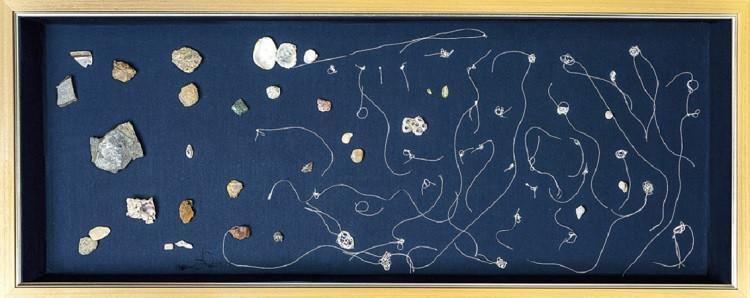
Suna and İnan Kıraç Foundation Pera Museum’s new exhibition is highlighting the global crisis under the influence of the pandemic. The exhibition titled “Crystal Clear,” curated by Elena Sorokina, brings together the works of 20 artists from different countries and generations who engage with the questions of transparency and opacity, earth and de-growth, and the extractive logic that we have to challenge.
The exhibition brings forth the reality of the times we are going through. Created in the context of the pandemic, the question of sustainability in artistic and curatorial practices became central for the exhibition, affecting changes in its structure and choices of material the artists would use.
Sorokina first researched artists’ works dealing with crystals and minerals and their porous borders between living and non-living matter.
“There is an endless amount of fascinating examples which travel between cultures. Turquoise, for example, is known for its ability to change color in reaction to the skin, so that its color becomes an extension of the one who wears it,” she said, adding that she got very interested by the impurities in crystals. The defining property of a crystal is the symmetry of its structure, which has long fascinated researchers and artists alike.
Sorokina managed to bring artists who created artworks related to crystals. The show features works by Sammy Baloji, Minia Biabiany, Katinka Bock, Bianca Bondi, Gaëlle Choisne, Kıymet Daştan, Elmas Deniz, Sinem Dişli, Gluklya (Natalia Pershina-Yakimanskaya), Deniz Gül, Ilana Halperin, Gülsün Karamustafa, Yazan Khalili, Paul Maheke, Şener Özmen, İz Öztat, Hale Tenger, Güneş Terkol, Berkay Tuncay and Adrien Vescovi.
According to the curator, crystals serve the artists and the exhibition as a “matter of concern.” And they proved a very fruitful matter, allowing the artists to speak about the extractivism, transparency and opacity, earth and de-growth, and to reflect on mysteries and ambiguities between living and non-living, organic and non-organic states. All of this connects us to the current crises.
Sorokina somehow also managed to relate all these with a more ontological question and curated the show in practical terms. “In this context, the question about sustainability of artistic and curatorial practices became central.”
She asked herself how to curate ecologically and with care and how to reduce the carbon footprint of exhibitions - crystallized as our main concerns. The histories, qualities and uses of crystals and minerals provide the basis for the conceptual framework of the exhibition.
Having properties ranging from almost perfect transparency to complete opacity, crystals have been used in all areas of human activity, from science and magic to technology and healing. They constitute a perfect emblem for the fluid and porous borders between animate and inanimate, organic and inorganic.
“Scientists typically describe crystals as ‘growing,’ even though in their eyes they are not alive. Many living organisms, such as mollusks, are able to produce crystals. In many ancestral cultures, crystals and minerals were regarded as sentient. They also belong to the earliest examples of extraction,” Sorokina explained.
Bruno Latour’s essay on pandemic
The ontological question somehow spreads into a more sociological stance with Sorokina’s curation. As a result, the project was inspired by Bruno Latour’s “Down to Earth: Politics in a New Climatic Regime,” Byung-Chul Han’s “The Transparency Society,” and Leanne Betasamosake Simpson’s ideas on extractivism. Simpson argues that extraction is not just about mining and drilling; it is a mind-set, an approach to nature, to ideas, and to people, and it is this mind-set and approach that we must change.
Latour’s text poses questions about how to evaluate the full shutdown of the economy and how to use this situation for ecological change. “This is why I thought it should be translated into Turkish and included into the catalog of the exhibition,” said Sorokina.
With “Crystal Clear,” Sorokina aimed at creating something more biological, a small crisis-resistant ecosystem of relations, exchanges, empathies, networks of support.
“In this situation, as curator, you give up the ‘bird eye’s view’ on the exhibition, you look at it from within, you don’t control all the elements, which evolve under the influence of so many causes and effects. I am also very attached to certain use-value of exhibitions, be they pedagogical, sustainable, social or other.’”
“Crystal Clear” reflects the programmatic approach taken to address these questions, insofar as it radically limited the shipping of objects, supported local collaborative production of exhibited work as well as creative recycling strategies, and greatly reduced the amount of travel for all participants. In other words, it adhered to the principles of a contained ecosystem of relations and a small circular economy by developing methods and tools to reduce the project’s carbon footprint in the dynamic interaction between production, display and recycling.
The exhibition will continue until March 7.